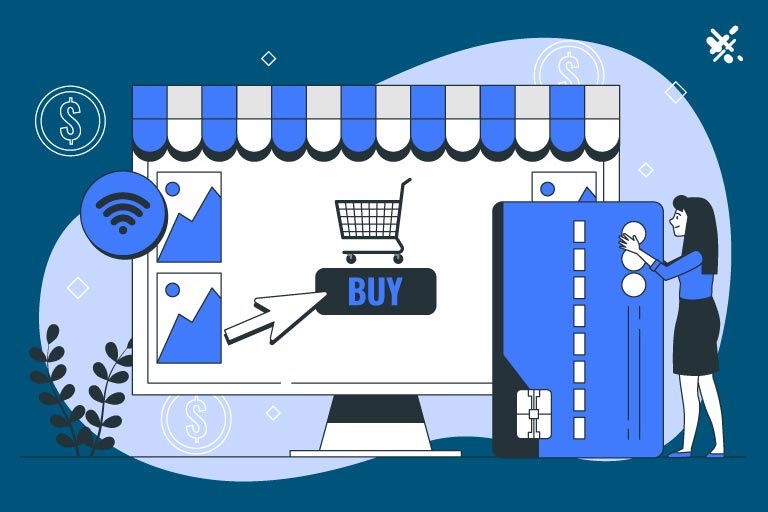For merchants who are selling products or services and accept credit card payments online, eCommerce chargebacks are a serious problem. A chargeback is when a customer disputes a charge on their credit card. They contact their bank or credit card issuer, instead of asking you (the merchant) for a refund. There are a number of reasons why the customer might go over your head. But they all result in chargeback fees.
Reducing chargebacks is important because chargeback fees are expensive. Moreover, if your chargeback ratio or chargeback rate is too high, you’ll be labeled a high-risk merchant. Your current payment processor might drop you, and card networks will be reluctant to work with you. Since online merchants can’t take cash or paper checks, high chargebacks can be the end of your cash flow.
There are ways to dispute a chargeback, but there are also ways to prevent chargebacks ab initio (before they begin). It’s good to be familiar with the dispute process. This way you can deal with the inevitable fraud chargebacks and false chargebacks (also called friendly fraud). But it’s equally important to have good customer service in place. This prevents the occurrence of chargebacks sourced in honest consumer frustration.
Note: a high chargeback to transaction ratio is anything over 1%. Yeah, we know. That’s not really a lot of wiggle room. So let’s dive deeper into this article so that we can better help you to avoid and fight these pesky little problems that many merchants just like yourself have to navigate on a daily basis.
How Does a Chargeback Work?
A chargeback begins when a customer asks their card issuer to reverse a transaction. Note that the card issuer is whatever financial institution gave the cardholder that credit card, whether it was a bank, their local credit union, or even a card network like American Express or Discover.
To explain a little more, Visa cards are not provided by Visa directly, but through consumer banks. Although Mastercard does have its own credit card. This detail is important because it shows you that there are a number of players in the payment landscape. Increasing the cost of chargebacks when they happen.
Cardholder Files a Dispute with the Issuing Bank
More often than not, this process will begin because a customer sees a charge they do not recognize on their credit card statement. In some cases, they may recognize the charge but were unaware that they were paying for it (such as a recurring payment for a subscription service).
And in some unfortunate (but increasingly common) cases, the customer does recognize the charge and decides to start the dispute process anyway. Because they know they will likely get their money back. With 68% of customers winning the transaction amount back, the odds are already in their favor.
The Issuing Bank and Acquiring Banks Talk
The bank behind their card brand (the issuing bank) will reach out to your bank (the merchant bank) to discuss the disputed transaction. In the meantime, they’ll issue a provisional credit to the customer’s account.
Merchant Account is Debited
Once your bank gets word of the chargeback, they’ll debit your account and charge you some lovely fees as well. Cheers! Even if you ultimately win the chargeback process, they’ve got to cover their behind in the meantime—and they’ll keep the fees.
At this point, your bank will reach out to you to see what you think. They will let you know the reason the customer initiated a dispute. Giving you the opportunity to dispute the chargeback.
Merchant Decides to Fight the Chargeback
Your options at this point are to either accept the chargeback or contest it by submitting a rebuttal letter and providing some compelling evidence that the charge was legitimate.
Take note that the issuing bank (defending the cardholder) may not provide the right reason for the chargeback. If so, the chargeback reason code given to you (the merchant) will not guide you toward the right line of defense. If you’re not going to roll over, you may want to put some effort into contacting their bank or even the customer.
You are legally allowed to contact the customer about the chargeback if the charge seems legitimate. Note that this process may be time-consuming. The customer may also be unwilling to talk to you or withdraw the dispute. Especially if it was a case of friendly fraud (where the customer got what they paid for and then pretends they didn’t).
However, you may have some success in understanding the nature of the dispute and convincing the customer to contact their bank and work out a refund or exchange with you accordingly. If that does transpire (to your benefit) do not forget to (politely) follow up with the customer and make sure they withdrew their dispute.
But whether or not you speak to the customer, once the issuing bank receives your rebuttal and evidence, they will assess it all and decide whether to reverse or uphold the chargeback. If they decide against you, there is still recourse available. You can take your chargeback dispute into arbitration with the card network, which will arbitrate between you and the issuing bank.
How to Fight an eCommerce Chargeback Through Arbitration
The entire process described above is called representment. And if the merchant is dissatisfied with how that process went, they can take it into arbitration. But before they get there, there may be something called pre-arbitration. This can occur if the bank discovers a new reason for the chargeback. Requiring the merchant’s response.
This is the last chance for the merchant to accept the chargeback (based on new evidence that they can or cannot refute), or for the issuing bank to accept a second rebuttal. If they still cannot work things out, the card network will step into the process for a final say, if the merchant decides that’s the direction they want to go.
The downside of arbitration is that the cost of losing is high. Both Visa and Mastercard fine a losing merchant $500 for filing fees. They may charge additional money if it’s discovered that the merchant violated any terms of service. Better than a pound of flesh, you might say.
Is Arbitration Worth It?
But Shakespearian references aside (Merchant of Venice, for you Jeopardy-hopefuls), for many business owners, the possibility of losing and having to pay these filing fees is a significant deterrent.
They are not going to present any new evidence, because all the evidence they already have has been presented to the issuing bank. As such, if the bank presents any evidence or new angles of discussion, the merchant may be poorly equipped to dispute the chargeback after all.
Yes, you can hire a lawyer to help dispute chargebacks. Just keep in mind that lawyers with a specialization can cost up to $300 per hour or more. The average credit card purchase is around $91.
Furthermore, estimates suggest that on average, chargeback fees cost a merchant $3 for every $1 lost. Which means, you’re looking at up to $270 in addition to the lost sale of $91 (using average numbers). Plus the processing fees you had to pay for the original transaction.
With these kinds of rates, that lawyer better figure out how to win your case in about 30 minutes. Otherwise, it’s not worth it. Of course, if your tickets are larger than that, or if one particular purchase was very large, it could be worth it to hire legal help. This type of decision needs to be parsed out on a case-by-case basis. But generally speaking, getting legal help for your arbitration is not cost-effective.

The Best Way for Merchants to Fight eCommerce Chargebacks
The best defense is a good offense. Although this phrase may strike some as cliche, it’s the cornerstone of avoiding chargebacks. As we’ve seen, the chargeback process is time-consuming and woefully cost-ineffective to fight. This means that the best path forward is to make sure chargebacks don’t happen in the first place.
For brick-and-mortar merchants, this can be easy enough. One way to reduce chargebacks based on fraud claims is to only accept cards with EMV chips or contactless NFC-enabled pay. As magnetic strips are notoriously easy to use for counterfeit cards.
This is because the information is statically stored, in contrast to payment methods that generate random tokens each time, like EMV and contactless payments. But even these types of payments won’t negate chargebacks entirely for in-person transactions.
But how can you work to prevent chargebacks online? The customer is not in front of you. So, you can’t ask to use EMV chip cards or NFC contactless payment methods. And you can ask for their ID if you are suspicious of a customer using a stolen card.
All you can do is collect their payment information (keyed) and hope that the person inputting it to the virtual payment gateway is the cardholder.
Stay in Touch: An eCommerce Chargeback Reduction Plan
As mentioned, many times, it is the cardholder. And moreover, many of these cardholders have no intention of making a fraudulent chargeback. There’s a decent chance they just want to stop paying for whatever services they are subscribed to. If your business is a subscription model, make sure you are staying in front of your customers.
You may have used something like a direct marketing approach like an email-based sales funnel to get these customers in the first place. You should continue to use email as a way of staying in touch with them, at least once a week. This proactive step can eliminate a significant number of chargebacks from customers who forgot what they are paying for.
Another thing you can do is keep lines for communication open. At the very least, your customer care email and phone number should be accessible, It should be displayed on all of your communications (paper and email), on your social media profiles, and on your website. Customers who can reach you may contact you for a refund instead of going over your head.
Free Trials, Short-Term Memory Loss, and Discreet Packages
Sometimes customers initiate a chargeback because by the time they realize they want to stop paying for something, they’re already past the statute of limitations you’ve set for refunds. You will have to put some thought into your refund and cancellation policy here. Because it’s somewhat of a razor’s edge: too flexible, and you could be losing money. Too tight, and you could be losing even more money—through chargebacks.
One popular subscription setup these days is to provide a free trial. But only after the customer has provided their credit card information. In terms of chargebacks, this can be a recipe for disaster.
Once the 7, 21, or 30-day free trial is over, the customer may have forgotten what they were subscribed to. Carefully weigh the pros and cons of such a sales funnel. Especially if you are a small business.
Of course, if the subscription you’re selling is the delivery of tangible goods, like food, coffee, wine, or a monthly box of niche products, you’re hopefully staying in front of your customer already (by delivering the goods).
You should still make sure your contact info is accessible. Moreover, you should also make sure your business name is the same name they’ll see on their bank statement. This is an especially important detail for businesses that send discreet packages to take note of.
What is eCommerce Triangulation Fraud?
Now, onto the juicy stuff. You’ve heard of love triangles. But, what about sales triangles? Triangulation fraud is one of the latest snake oil crazes hitting the Wild West of the internet.
In a broad overview, a fraudster will pose as a merchant, selling items at unusually low prices. When a customer places an order, the “merchant” will pocket the payment. Then they will use that credit card information to make an actual purchase from a real purveyor of the goods in question, at their normal prices.
Of course, these goods are probably going to be a lot more expensive than those the “merchant” is selling. But that’s not their problem. The product will be shipped to the customer, the original “merchant” will pocket their money, and the real merchant will be left with a chargeback once the customer sees the sale (made on their behalf) on their bank statement.
The fraud loop is a significant part of the $130 billion that card-not-present fraud will cost merchants by the end of 2023. To make matters worse, once a fraudster discovers a particularly vulnerable merchant, they will target this merchant over and over again.
There are a few warning signs of such activity:
- A new customer starts purchasing the same items on a regular basis.
- The billing and shipping addresses do not match.
The items in question are low-ticket items that the fraudster is running in batches. But generally speaking, if you’re running a business full-time, you probably don’t have the time to play Matlock or Chargeback She Wrote.
How to Prevent eCommerce Chargeback Scams
As a merchant, you may be wondering, how to prevent chargeback fraud. Well, fraud prevention is something best outsourced to the servicer of your merchant account, or your payment processor. A few of the back-end tools they can provide include address verification (AVS), CVV verification, geolocation verification, and blacklists of known fraudsters.
There are additional high-tech tools that can be leveraged, such as Proxy Piercing. Proxy addresses are a sort of fake address for criminals who don’t want to give away their device’s real internet IP. To make a long story short, there are two types of proxies: data centers proxies and residential proxies.

Peekaboo…I See You
Through proxy piercing, your payment processor can see where the IP address is located. Either at a data center, or a residence. A residence is a sign of a greater likelihood of a more secure transaction—e.g. the actual cardholder in their own home.
However, by the same token, residential proxies are also more favored by savvy fraudsters. A data center is a greater sign of fraud. Because the “cardholder” is hiding behind a more public IP (that of the data center) while obscuring their own.
If you’re wondering where the epicenters of eCommerce credit card fraud are, the top ten offenders in Europe are Ukraine, Hungary, Romania, and Greece. In the Americas, they are Brazil, Mexico, and Columbia. And in Asia, they are China and the Philippines.
As you can see, chargeback fraud cases can be stopped before they begin, if you have the right tools. Unfortunately, having the right tools is expensive and cost-prohibitive. Moreover, in the ever-shifting landscape of credit card chargeback fraud, they will need maintenance and periodic upgrading
Better to outsource these backend costs to the merchant account taking the payments, and all their proprietary tools. Sometimes these tools are powerful enough to even lock down a physical residence associated with the transaction. Peekaboo…and the card declined.
Friendly Fraud
Friendly fraud is also on the rise, where customers will pretend that they didn’t get what they paid for. Certain industries are more targeted than others. But across the board, friendly fraud will cost eCommerce merchants around $48 billion by the end of 2023. That’s up 16% from the previous year. Part of this increase is legislation that defends and protects consumers, with the obvious downside of making it easier for some unscrupulous shoppers to game the system.
There are a few ways you can reduce chargebacks from this type of eCommerce fraud. One is to collect and retain payment details so that in a disrupted transaction, you present these as compelling evidence of a willful purchase. Like the triangulation fraud mentioned above, this is another process that a good payment processor can best facilitate.
But there are also some methods in your control. If you are delivering goods, requiring customers to sign for packages can lower your friendly fraud chargeback thresholds. Of course, this can create a negative customer experience.
But thankfully, carriers like FedEx are taking a page from the Amazon playbook and offering photo proof of package delivery. Can you hear the mic drop in the Visa arbitration chamber?

eCommerce Chargeback Protection
Fighting a chargeback is a costly and time-consuming process that (more often than not) is not worth it. Unfortunately, chargebacks are common in eCommerce because the internet is a sort of digital Wild West. In the end, reducing your eCommerce chargeback rate is easiest to do with some proactivity.
Hopefully, you’ve seen that there are some best business practices you can implement to limit chargebacks, like delivery verification, staying in touch with customers, and making yourself accessible to frustrated customers. But then there are also some backend fraud prevention tools that are most likely too cumbersome or expensive for you to implement.
Working with a good payment processor can help you get the fraud prevention you need, so you don’t have to fight chargebacks.
To contact sales, click HERE. And to learn more about ECS E-commerce Payment Processing visit Online Payments.
